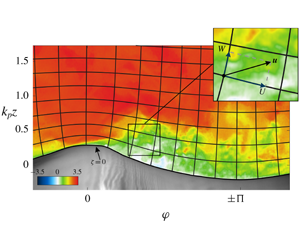Crossref Citations
This article has been cited by the following publications. This list is generated based on data provided by
Crossref.
Hu, Haode
and
Ma, Dongli
2020.
Airfoil Aerodynamics in Proximity to Wavy Ground for a Wide Range of Angles of Attack.
Applied Sciences,
Vol. 10,
Issue. 19,
p.
6773.
Cao, Tao
Deng, Bing-Qing
and
Shen, Lian
2020.
A simulation-based mechanistic study of turbulent wind blowing over opposing water waves.
Journal of Fluid Mechanics,
Vol. 901,
Issue. ,
Yousefi, Kianoosh
Veron, Fabrice
and
Buckley, Marc P.
2020.
Momentum flux measurements in the airflow over wind-generated surface waves.
Journal of Fluid Mechanics,
Vol. 895,
Issue. ,
Cao, Tao
and
Shen, Lian
2021.
A numerical and theoretical study of wind over fast-propagating water waves.
Journal of Fluid Mechanics,
Vol. 919,
Issue. ,
Yousefi, Kianoosh
Veron, Fabrice
and
Buckley, Marc P.
2021.
Turbulent and wave kinetic energy budgets in the airflow over wind-generated surface waves.
Journal of Fluid Mechanics,
Vol. 920,
Issue. ,
Morse, Nicholas
and
Mahesh, Krishnan
2021.
Large-eddy simulation and streamline coordinate analysis of flow over an axisymmetric hull.
Journal of Fluid Mechanics,
Vol. 926,
Issue. ,
Paskin, Liad
Conan, Boris
Perignon, Yves
and
Aubrun, Sandrine
2022.
Evidence of Ocean Waves Signature in the Space–Time Turbulent Spectra of the Lower Marine Atmosphere Measured by a Scanning LiDAR.
Remote Sensing,
Vol. 14,
Issue. 13,
p.
3007.
Xuan, Anqing
and
Shen, Lian
2022.
Analyses of wave-phase variation of Reynolds shear stress underneath surface wave using streamline coordinates.
Journal of Fluid Mechanics,
Vol. 931,
Issue. ,
Dwivedi, Anubhav
Sidharth, G.S.
and
Jovanović, Mihailo R.
2022.
Oblique transition in hypersonic double-wedge flow.
Journal of Fluid Mechanics,
Vol. 948,
Issue. ,
Esteghamatian, Amir
Katz, Joseph
and
Zaki, Tamer A.
2022.
Spatiotemporal characterization of turbulent channel flow with a hyperelastic compliant wall.
Journal of Fluid Mechanics,
Vol. 942,
Issue. ,
Paskin, Liad
Conan, Boris
Perignon, Yves
and
Aubrun, Sandrine
2022.
A Dynamic Large-Scale Driving-Force to Control the Targeted Wind Speed in Large Eddy Simulations above Ocean Waves.
Atmosphere,
Vol. 13,
Issue. 12,
p.
2012.
Cao, Tao
Liu, Xu
Xu, Xiaowen
and
Deng, Bingqing
2023.
Investigation on mechanisms of fast opposing water waves influencing overlying wind using simulation and theoretical models.
Physics of Fluids,
Vol. 35,
Issue. 1,
Wang, Qiu
Li, Jinping
and
Gu, Sangdi
2024.
Hypersonic boundary layer theory in the symmetry plane of blunt bodies.
Journal of Fluid Mechanics,
Vol. 997,
Issue. ,
Yousefi, Kianoosh
Hora, Gurpreet Singh
Yang, Hongshuo
Veron, Fabrice
and
Giometto, Marco G.
2024.
A machine learning model for reconstructing skin-friction drag over ocean surface waves.
Journal of Fluid Mechanics,
Vol. 983,
Issue. ,
Do, Jitae
Wang, Binbin
and
Chang, Kuang-An
2024.
Turbulence over young wind waves dominated by capillaries and micro-breakers.
Journal of Fluid Mechanics,
Vol. 985,
Issue. ,
Tan, Peisen
Savelyev, Ivan
Laxague, Nathan J. M.
Haus, Brian K.
Curcic, Milan
Matt, Silvia
Zappa, Christopher J.
Mehta, Sanchit
and
Wray, Sydney
2025.
Wind‐Wave Momentum Flux in Steep, Strongly Forced, Surface Gravity Wave Conditions.
Journal of Geophysical Research: Oceans,
Vol. 130,
Issue. 1,
